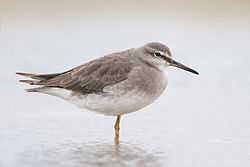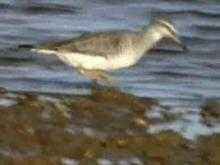Grey-tailed Tattler
| Grey-tailed Tattler | |
|---|---|
 | |
| Breeding plumage | |
 | |
| Non-breeding plumage | |
| Conservation status | |
| Scientific classification | |
| Kingdom: | Animalia |
| Phylum: | Chordata |
| Class: | Aves |
| Order: | Charadriiformes |
| Family: | Scolopacidae |
| Genus: | Tringa |
| Species: | T. brevipes |
| Binomial name | |
| Tringa brevipes (Vieillot, 1816) | |
| Synonyms[2] | |
|
Heteroscelus brevipes | |
The Grey-tailed Tattler or Polynesian Tattler,[2] Tringa brevipes (formerly Heteroscelus brevipes: Pereira & Baker, 2005; Banks et al., 2006), is a small, foraging shorebird in the genus Tringa, and breeds in northeast Siberia. After breeding, they migrate to an area from southeast Asia to Australia.
Description
The Grey-tailed Tattler is closely related to its North American counterpart, the Wandering Tattler (T. incana) and is difficult to distinguish from that species. Both tattlers are unique among the species of Tringa for having unpatterned, greyish wings and back, and a scaly breast pattern extending more or less onto the belly in breeding plumage, in which both also have a rather prominent supercilium.
These birds resemble Common Redshanks in shape and size. The upper parts, underwings, face and neck are grey, and the belly is white. They have short yellowish legs and a bill with a pale base and dark tip. There is a weak supercilium.
They are very similar to their American counterpart, and differentiation depends on details like the length of the nasal groove and scaling on the tarsus. The best distinction is the call; Grey-tailed has a disyllabic whistle, and Wandering a rippling trill.

Behaviour
Its breeding habitat is stony riverbeds in northeast Siberia. It nests on the ground, but these birds will perch in trees. They sometimes use old nests of other birds as well.
Grey-tailed Tattlers are strongly migratory and winter on muddy and sandy coasts from southeast Asia to Australia. They are very rare vagrants to western North America and western Europe. These are not particularly gregarious birds and are seldom seen in large flocks except at roosts.
These birds forage on the ground or water, picking up food by sight. They eat insects, crustaceans and other invertebrates.
Conservation status
Australia
Grey-tailed Tattlers are not listed as threatened on the Australian Environment Protection and Biodiversity Conservation Act 1999.
State of Victoria, Australia
- The Grey-tailed Tattler is listed as threatened on the Victorian Flora and Fauna Guarantee Act (1988). Under this Act, an Action Statement for the recovery and future management of this species has not been prepared.
- On the 2007 advisory list of threatened vertebrate fauna in Victoria, the Grey-tailed Tattler is listed as critically endangered.[3]
References
- ↑ BirdLife International (2012). "Heteroscelus brevipes". IUCN Red List of Threatened Species. Version 2013.2. International Union for Conservation of Nature. Retrieved 26 November 2013.
- ↑ 2.0 2.1 Tringa brevipes on Avibase
- ↑ Victorian Department of Sustainability and Environment (2007). Advisory List of Threatened Vertebrate Fauna in Victoria – 2007. East Melbourne, Victoria: Department of Sustainability and Environment. p. 15. ISBN 978-1-74208-039-0.
Further reading
- Banks, Richard C.; Cicero, Carla; Dunn, Jon L.; Kratter, Andrew W.; Rasmussen, Pamela C.; Remsen, J. V. Jr.; Rising, James D. & Stotz, Douglas F. (2006): Forty-seventh Supplement to the American Ornithologists' Union Check-list of North American Birds. Auk 123(3): 926–936. DOI: 10.1642/0004-8038(2006)123[926:FSTTAO]2.0.CO;2 PDF fulltext
- Shorebirds by Hayman, Marchant and Prater ISBN 0-7099-2034-2
- Hayman, Peter; Marchant, John & Prater, Tony (1986): Shorebirds: an identification guide to the waders of the world. Houghton Mifflin, Boston. ISBN 0-395-60237-8
- Pereira, Sérgio Luiz & Baker, Alan J. (2005): Multiple Gene Evidence for Parallel Evolution and Retention of Ancestral Morphological States in the Shanks (Charadriiformes: Scolopacidae). Condor 107(3): 514–526. DOI: 10.1650/0010-5422(2005)107[0514:MGEFPE]2.0.CO;2 HTML abstract
External links
| Wikimedia Commons has media related to Tringa brevipes. |
| Wikispecies has information related to: Tringa brevipes |
